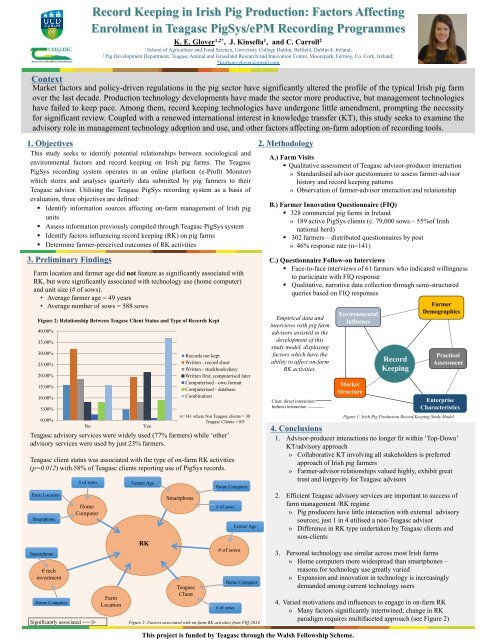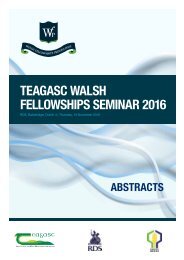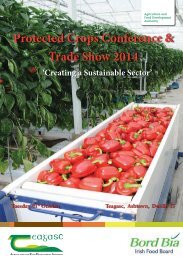Driving Farm Innovation through Knowledge Transfer
1S93ppX
1S93ppX
Create successful ePaper yourself
Turn your PDF publications into a flip-book with our unique Google optimized e-Paper software.
Record Keeping in Irish Pig Production: Factors Affecting<br />
Enrolment in Teagasc PigSys/ePM Recording Programmes<br />
K. E. Glover 1,2* , J. Kinsella 1 , and C. Carroll 2<br />
1<br />
School of Agriculture and Food Science, University College Dublin, Belfield, Dublin 4, Ireland;<br />
2<br />
Pig Development Department, Teagasc Animal and Grassland Research and <strong>Innovation</strong> Centre, Moorepark, Fermoy, Co. Cork, Ireland;<br />
*kaitlynn.glover@gmail.com<br />
Context<br />
Market factors and policy-driven regulations in the pig sector have significantly altered the profile of the typical Irish pig farm<br />
over the last decade. Production technology developments have made the sector more productive, but management technologies<br />
have failed to keep pace. Among them, record keeping technologies have undergone little amendment, prompting the necessity<br />
for significant review. Coupled with a renewed international interest in knowledge transfer (KT), this study seeks to examine the<br />
advisory role in management technology adoption and use, and other factors affecting on-farm adoption of recording tools.<br />
1. Objectives<br />
This study seeks to identify potential relationships between sociological and<br />
environmental factors and record keeping on Irish pig farms. The Teagasc<br />
PigSys recording system operates in an online platform (e-Profit Monitor)<br />
which stores and analyses quarterly data submitted by pig farmers to their<br />
Teagasc advisor. Utilising the Teagasc PigSys recording system as a basis of<br />
evaluation, three objectives are defined:<br />
• Identify information sources affecting on-farm management of Irish pig<br />
units<br />
• Assess information previously compiled <strong>through</strong> Teagasc PigSys system<br />
• Identify factors influencing record keeping (RK) on pig farms<br />
• Determine farmer-perceived outcomes of RK activities<br />
2. Methodology<br />
A.) <strong>Farm</strong> Visits<br />
• Qualitative assessment of Teagasc advisor-producer interaction<br />
» Standardised advisor questionnaire to assess farmer-advisor<br />
history and record keeping patterns<br />
» Observation of farmer-advisor interaction and relationship<br />
B.) <strong>Farm</strong>er <strong>Innovation</strong> Questionnaire (FIQ)<br />
• 328 commercial pig farms in Ireland<br />
» 189 active PigSys clients (c. 79,000 sows – 55%of Irish<br />
national herd)<br />
• 302 farmers – distributed questionnaires by post<br />
» 46% response rate (n=141)<br />
3. Preliminary Findings<br />
<strong>Farm</strong> location and farmer age did not feature as significantly associated with<br />
RK, but were significantly associated with technology use (home computer)<br />
and unit size (# of sows).<br />
• Average farmer age = 49 years<br />
• Average number of sows = 588 sows<br />
Figure 2: Relationship Between Teagasc Client Status and Type of Records Kept<br />
40.00%<br />
35.00%<br />
30.00%<br />
25.00%<br />
20.00%<br />
15.00%<br />
10.00%<br />
5.00%<br />
0.00%<br />
Teagasc advisory services were widely used (77% farmers) while ‘other’<br />
advisory services were used by just 23% farmers.<br />
Teagasc client status was associated with the type of on-farm RK activities<br />
(p=0.012) with 58% of Teagasc clients reporting use of PigSys records.<br />
<strong>Farm</strong> Location<br />
Smartphone<br />
Smartphone<br />
€ tech<br />
investment<br />
Home Computer<br />
No<br />
# of sows<br />
Home<br />
Computer<br />
<strong>Farm</strong><br />
Location<br />
Yes<br />
<strong>Farm</strong>er Age<br />
RK<br />
Smartphone<br />
Records not kept<br />
Written - record sheet<br />
Written - stockbook/diary<br />
Written first, computerised later<br />
Computerised - own format<br />
Computerised - database<br />
Combination<br />
n=141 where Not Teagasc clients = 38<br />
Teagasc Clients =103<br />
Teagasc<br />
Client<br />
Home Computer<br />
# of sows<br />
# of sows<br />
# of sows<br />
<strong>Farm</strong>er Age<br />
Home Computer<br />
Significantly associated Figure 2: Factors associated with on-farm RK activities from FIQ 2014.<br />
C.) Questionnaire Follow-on Interviews<br />
• Face-to-face interviews of 61 farmers who indicated willingness<br />
to participate with FIQ response<br />
• Qualitative, narrative data collection <strong>through</strong> semi-structured<br />
queries based on FIQ responses<br />
Empirical data and<br />
interviews with pig farm<br />
advisors assisted in the<br />
development of this<br />
study model, displaying<br />
factors which have the<br />
ability to affect on-farm<br />
RK activities.<br />
Clear, direct interaction<br />
Indirect interaction<br />
4. Conclusions<br />
Environmental<br />
Influence<br />
Market<br />
Structure<br />
Record<br />
Keeping<br />
<strong>Farm</strong>er<br />
Demographics<br />
Practical<br />
Assessment<br />
Enterprise<br />
Characteristics<br />
1. Advisor-producer interactions no longer fit within ‘Top-Down’<br />
KT/advisory approach<br />
» Collaborative KT involving all stakeholders is preferred<br />
approach of Irish pig farmers<br />
» <strong>Farm</strong>er-advisor relationships valued highly, exhibit great<br />
trust and longevity for Teagasc advisors<br />
2. Efficient Teagasc advisory services are important to success of<br />
farm management /RK regime<br />
» Pig producers have little interaction with external advisory<br />
sources; just 1 in 4 utilised a non-Teagasc advisor<br />
» Difference in RK type undertaken by Teagasc clients and<br />
non-clients<br />
Figure 1: Irish Pig Production Record Keeping Study Model.<br />
3. Personal technology use similar across most Irish farms<br />
» Home computers more widespread than smartphones –<br />
reasons for technology use greatly varied<br />
» Expansion and innovation in technology is increasingly<br />
demanded among current technology users<br />
4. Varied motivations and influences to engage in on-farm RK<br />
» Many factors significantly intertwined; change in RK<br />
paradigm requires multifaceted approach (see Figure 2)<br />
This project is funded by Teagasc <strong>through</strong> the Walsh Fellowship Scheme.




